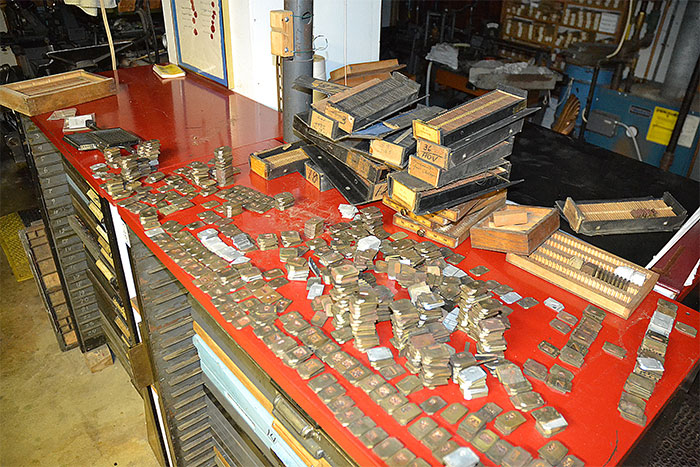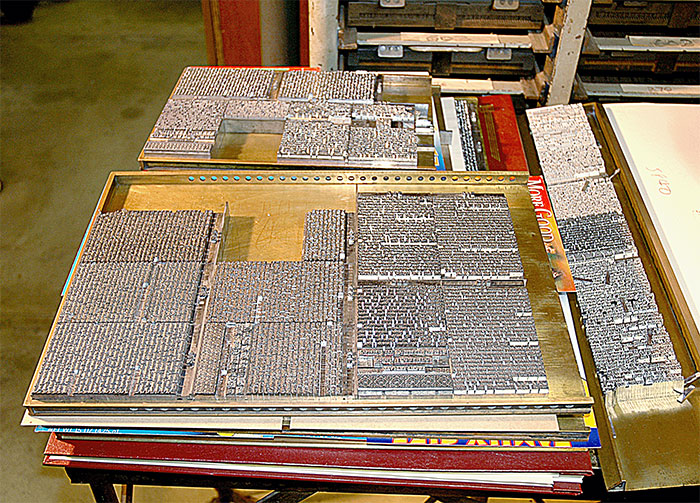It was an extremely rare occurrence when materials were found in anything but a chaotic mess which had to be carefully opened up, spread out, studied, sorted, and most often, removed to packaging which would be more durable. Boxes from the Lanston Monotype Machine Company in Philadelphia served well for perhaps half a century, but mold, dampness, and mishandling rendered most beyond repair, so they were discarded and the matrices from those boxes stored in special plastic boxes which compressed the collection from five boxes to one.
A Quick View of Our Plant and Typefoundry
In this way a assemblage which exceeds 4,000 fonts of matrices was reduced to an orderly collection filling one wall in our basement shop. Over the years, acquisitions resulted in several duplicates of various fonts. Each individual font was studied closely and the best, most complete examples were retained with the duplicates being sold or bartered with other individuals with similar interests. Of course a detailed inventory was compiled beginning with our first computers in the early 1980s and updated as frequently as possible.
Whenever possible large countertops have been incorporated into the tight space making it more convenient for sorting and laying out of materials when work is “in progress.” The red counter full of mats being sorted. The counter below the cream-colored display matrix boxes is almost clean—a highly unusual situation. It is more common to see it heavily cluttered. The countertop at right is a more common occurrence, with tools, molds, matrices, oil cans, rags, and manuals laid out all for instant access. This photo also shows a large number of Monotype Composition Matrix Cases readily available with associated wedges. But this is only a portion of the over 1,000 Matrix Cases on hand in the shop. The white drawers top left in the photo is filled with literally thousands of individual Composition Matrices sized 1/5 inch square and about half an inch tall. These are auxiliary characters, replacement characters, and in many instances duplicates, mostly inventoried and readily accessible.
The plant is equipped with casting equipment capable of making any and all types needed for a project, as well as strip material (leads, slugs, decorative rules, etc.). There are over six full stands of typecases and a large percentage of the type in those cases has been cast on site. The blue-colored stand still is preferred as the place where most imposition is done. The stand was built by Rich and his father in the 1950s.
The ability to make one’s own type enables complete assembly of multi-page documents (and books!) before any presswork is necessary. Additionally, after printing, the work can be remelted for making a new type. There is no need to distribute type composition as a general rule.
At the Hill & Dale, typographic ornaments are an obsession. Thousands of ornament matrices are on hand and large quantities of these ornaments frequently are assembled to create decoration and fascinating designs. Occasionally ornaments and decorative fonts are cast for others.
The great bulk of the presswork completed at the Hill & Dale is done on the 10×15 Heidelberg “Windmill” press. It is capable of the most exacting color registration and is frequently used for multi-colored projects involving ornamental designs.
Several “table-top” platen presses are on hand more as a collection than for actual use in printing. Indeed, it is more difficult to do “good work” on a table-top press than on much larger equipment. The first press acquired in 1955 by the Hill & Dale, a 7×11 Golding Pearl Press still is on hand and is used frequently for projects such as postcards, small leaflets, and occasional business cards. The most recent acquisition was the 13×19 Heidelberg Windmill, a marvelous piece of equipment with superior ink distribution thanks to a system utilizing ten different ink rollers.
This press is used for projects measuring up to 11×17 with ease.
Not to be out-done, Hill & Dale also is equipped with a Vandercook No. 4 reproduction proof press, which is heavily used for proofing, and for printing runs of posters and similar specimens sized up to 15×20 inches.
There’s no question that the Hill & Dale shop is the envy of most discerning letterpress enthusiasts. However, that envy must be tempered by the realization that the shop was gathered in many phases over a period which now exceeds sixty-five years.
















